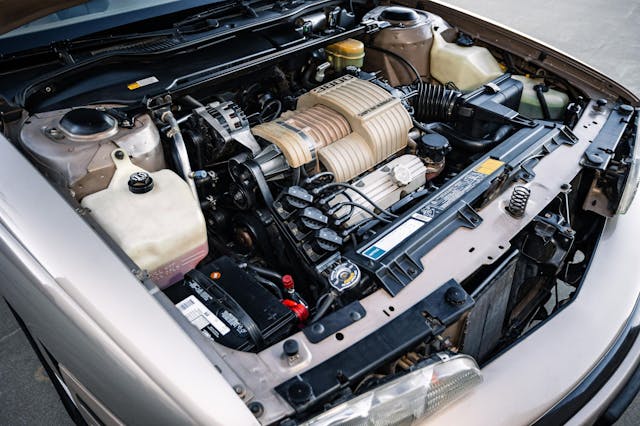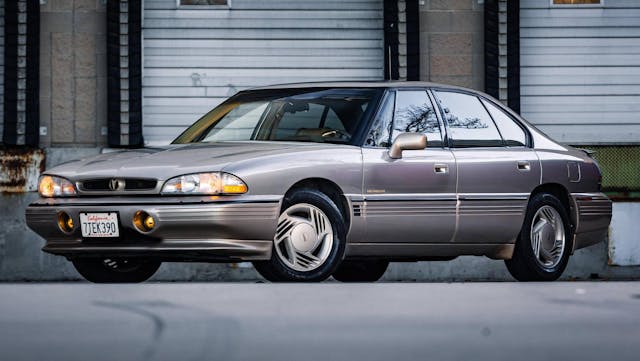’90s cars are hot, but not this honest American family car
Want a better understanding of what’s driving collector-car values? Sign up for the Hagerty Insider newsletter.
I grew up in a family that exclusively bought General Motors vehicles. Why this was the case, I can’t really say. We lived on the East Coast, and no one we knew worked for any of the Big Three. Nowadays any kind of loyalty carries a tinge of hyper-partisanship; back then, it felt more like a simple fact. Just as we happened to be Jews and happened to be from New England, so we happened to always have a front-drive GM blob in the driveway.
I was brought home from the hospital in a Chevrolet Celebrity, which was traded for a Pontiac Sunbird and then a procession of Bonnevilles. I spent middle school climbing into the back seat of a Chevrolet Monte Carlo (the two-door Lumina variant), which was upgraded—thrillingly, to me at the time—to a Pontiac Grand Prix GTP.
All of this is a long way of explaining my joy at seeing a 1993 Pontiac Bonneville SSE Supercharged sell for $6061 (including fees) on Cars & Bids.
“Supercharged,” in this and practically every other case for General Motors in the 1990s and early 2000s, referred to a boosted version of GM’s venerable 3.8-liter V-6. It was, even in 1993, far from state-of-the-art—an OHV, iron-block engine that dated back to 1960s Buicks. Yet it produced 205 hp and 260 lb-ft of torque, which was a whole lot in 1993.
By the time this “3800” powerplant officially left the scene, in the 2007 Pontiac Grand Prix GT, it made 260 hp and 280 lb-ft of torque. Readily available bolt-ons, namely a smaller pulley, easily pushed output past 300 hp with little risk to the engine (the transmission was another matter).
I’ll come right out and say it: These were great engines.

Lest I get ahead of myself (or in case I already have), it’s worth adding that the Bonneville SSE was not a great car, and neither were any of the other GM front-drivers of the era. By 1993, Japanese automakers had utterly perfected the family sedan—one could make the case that the 1991–96 Toyota Camry, a Lexus in all but name, is the greatest front-drive family sedan of all time. Ford had battled back with the best-selling Ford Taurus and even Chrysler, under the auspices of Bob Lutz, was rolling out slick-looking, “cab-forward” LH-platform cars. GM was otherwise occupied.
In the 1980s the General had thrown billions at front-drive cars that, even when new, failed to match the refinement of class leaders. It entered the 1990s posting losses that were, at that point in the company’s history, unprecedented. The hard times manifested themselves in hard interior plastic panels and overall poor fit and finish. (I can recall, even as an eight-year-old, noticing paint runs in our white 1993 Bonneville SE).
Although practically all GM brands and cars suffered, few fared worse than the once-proud Pontiacs, which continued to be marketed as performance cars but increasingly failed to keep up with competition. These Bonnevilles accelerated well and cruised the highway with languid ease but lacked the agility of a contemporary Nissan Maxima, to say nothing of the era’s BMWs.
Not that my parents—or hundreds of thousands of other parents—were really cross-shopping 5 Series and the like. GM was losing market share, but still built more than one out of every three cars sold in the United States when this Bonneville found its first owner. Since then, this beige and brown family sedan has clearly lived a pampered existence, racking up 167,000 miles and showing only minor wear to its heavily bolstered driver’s seat. The 1990s GM gimmickry gadgetry, including a head-up display and primitive trip computer, now lend a distinct time-capsule feel, although it’s hard to say if they all work going just by the photos.

Hagerty fielded only a handful of calls from people interested in insuring 1992–1997 Bonnevilles in the past year. The median value cited is $6000, making this sale right on the money. Even the best American cars of this era have by and large been left behind as 1990s vehicles appreciate. These front-drive GM sedans, far from the best, are and remain an automotive underclass of a sort. And yet, they were always there, serving honestly in the background and, more specifically, in my family’s driveway.
It’s nice to see you, old friend.
***
Check out the Hagerty Media homepage so you don’t miss a single story, or better yet, bookmark it. To get our best stories delivered right to your inbox, subscribe to our newsletters.



I bought a new 2004 Pontiac GP GTP Competion Group. It was a fantastic car both the way it ran and the way it looked, especially with the optional rear spoiler, koni dealer installed springs and shocks, and chrome wheels. I installed a smaller supercharger pulley, new tune ECM, special ignition coils and wires, and a cat back SLP exhaust system. The car dyno run netted 302hp to the rear wheels. The car was such a sleeper and I blew away many a BMW!! Loved that car. Sold it when it just turned 200k miles and never had an issue with it.
Not to be a troll… but if you were getting that much HP out of the real wheels, I would love to know what the front wheels were doing…
Not the best styling on this car but almost restrained for Pontiac of that era with scoops, vents, etc. that did nothing. Still ribbed on the side (for your pleasure?)
No doubt the Japanese were churning out way better automobiles in that era than GM (probably still are)! But no matter how good they were, I always remember being so aware of how different the ride was. An when I say “ride”, I’m not referring to things that matter like suspension, handling, road feel, cornering etc., I simply mean COMFORT. The GM cars seemed to glide over bumps and potholes and were just so quiet! Never mind that they leaned over in a corner like a jet ski riding a wake….they were quiet and pleasant and nice to ride in. In short, our American fat assess appreciated the comfort and familiarity of a good old GM floating Titanic. As I get older, there is a part of me (likely my fat ass!) that longs for a column shifted, bench seated, wallowing cruise ship, with an optional FM radio.
Go easy on me…I’m old.
Indeed, that supercharged 3.8 was a good engine. We bought a 1998 Grand Prix GTP coupe new, ordered just the way we wanted. It was a month shy of 20 years old, and still running – and looking – great, when it gave its life to protect my wife from a drunk driver (whom they led off in handcuffs). We still miss the car.
As a lot of folks have pointed out – those cars are bulletproof and make great cars. As a collector car, the styling is a little quirky and they were a bit too heavy to really get the performance out of those 3.8s so I get it. I imagine that a lot of these out there are still serving as just a plain-ol car… with 200+K on the odo
The Japanese cars that these are often compared to tend to be lighter and smaller and really aren’t 1:1 comparisons
Growing up in the mid 90’s my family had the ubiquitous Gen 1 Taurus when it was getting long in the tooth it was time to shop for a new ride. My Dad was not necessarily anti GM. He was looking really hard at the 96 Chevrolet Lumina but my Mom did not like the look of it so that didn’t happen. Looking at other GM products of the 1996 model year he said “ The models were stale.” In 1996 most of the GM midsize to large sedans were about to be refreshed in 1997. He went with LH Interipd which turned out to be one of the worse cars he ever owned. Most of the trim fell off or cracked on it, the Factory battery died at 8 months into ownership. The transmission was completely rebuilt at 45k, and the last straw was a steering rack that was replaced at 80k. It was the only car he ever traded out before it was 10 years old.
I got a new job with a long commute and needed something really cheap and reliable for the drive. I hunted for a Buick just for the 3800 V6 alone and they were easier to find in nice clean shape vs any of the Pontiacs /Camry’s/ Accords, in my price range. Now that I’ve had the car a few years and it’s asked for very little my Dad has seen how reliable it has been.
I asked him if he could go back and buy something else in 96’ what it would be. His response shocked me when he said “ A Bonneville, for the 3800 V6 knowing now how good that engine was and yours is and really the styling was good just not as aggressive as the Intrepid.”
I had a red 94 Chrysler LHS. A total head turner and really good car, except for Chrysler’s failure prone tranny.